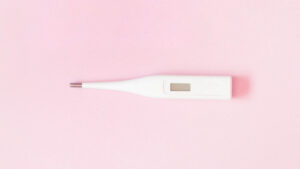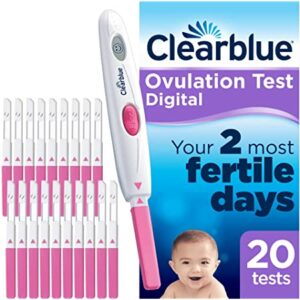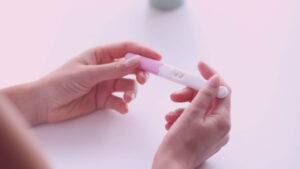How to calculate fertile days when you want to get pregnant
First of all, understand the menstrual cycle to be able to get pregnant
In an "ideal" cycle lasting 28 days, ovulation and therefore the release of the egg would occur on day 14 of the cycle. Just that day and the days before ovulation is when we are most fertile, and so, each woman's cycle.
In this post we are going to talk to you about different methods to determine the days on which you can get pregnant not only with the calendar, but also with the position of the cervix, with the graphs and basal temperature test and knowing your fertile cervical mucus which will allow the sperm to pass through and thus fertilize the egg and create an embryo that will implant during the second phase of your cycle.
Remember, to calculate your cycle, you have to take into account that the first day of your period is your day 1 and from here we count until the last day before the cycle starts again with a new menstruation or the period does not come because we are pregnant. Furthermore, menstrual cycles can not only be very different between women, but at different times in your life, you can have very different menstrual cycles and periods. Each woman is different and the best thing is to know your own menstrual cycle.
Ovulation and irregular cycles
For women who are not so regular in their cycles, these calculations are usually not enough to determine the date of ovulation as well as the fertile days and can make it difficult to get pregnant for this reason.
It has been shown (1) that, although the average woman usually has cycles between 27 and 28 days, even 58% of the cases studied had variations in their cycles of more than a week. With these calculations in mind, there are family planning systems based on sexual practice, with or without protection, depending on the objective, during a window of fertile days. For women with cycles of 26 to 32 days (78% in all cases) fertile days could be between days 8 to 19 of the cycle.
Already at the beginning of the century, the famous Dr. Ogino identified that menstruation came about 14 days after ovulation making the duration of this second part of the cycle more fixed, from ovulation to menstruation (Luteal Phase). Most irregularities in cycles are due to alterations in the first phase of the cycle, which goes from the first day of menstruation to ovulation (Follicular Phase) (2)
That If you have a cycle that is not 27 or 28 days, it does not mean that it is not a healthy menstrual cycle., nor that you cannot detect your fertile days or that you are going to have problems getting pregnant. The important thing is that this cycle is as regular as possible and that you can detect other ovulation symptoms that give you clues since the calendar is not going to be your best ally to enhance and schedule sexual relations.
The menstrual cycle must be coordinated
The body works like a musical orchestra where each element has its specific function but where only with the sum of the joint work is the precious melody achieved.
For the eggs to mature, for them to be able to leave their follicle and ovulate, for them to receive sperm, for them to travel to the uterus... For everything, coordination between substances, hormones and mechanisms that make it possible is necessary. And these physiological changes usually have a subtle but perceptible physical impact that we can be attentive to.
Teaching women to identify these changes is the only way to identify when their fertile days are. And like all teaching, It requires time of attention and practice to be useful. But of course, if you want to get pregnant, knowing your menstrual cycles and fertile days will be very important to know when to enhance sexual relations.
5 ways to know your ovulation
👉 Changes in vaginal discharge:
The increase in estrogen generated by the follicle when it matures favors the production of a type of lubricating mucus that facilitates the ascent of sperm towards the uterine cavity. This mucus will evolve until it changes its composition and texture, induced in this case by the hormone progesterone, to the opposite, to block the passage of sperm and reduce their survival. Note that Sperm can live 3 to 5 days inside a woman's body. waiting for the mature egg, so if you have had sex in the days before ovulation, whether two days, three days or up to 5, you have the possibility of getting pregnant if you have had unprotected sex.
During the cycle, it will change in density: from more creamy or grassy to more liquid or slippery; in elasticity: from thickest to most elastic; and in color: it will go from being more yellow to white or transparent.
The appearance of changes in the vaginal discharge indicate the beginning of fertility usually occurs around 5 or 6 days before ovulation, a period that coincides with what we have seen so far. The body is wise.
The so-called 'peak day' is the last day that the mucus is elastic and transparent, similar to egg white. Or the last day in which a sensation of lubrication or humidity is evident in the vagina. And it is usually a sign that ovulation has already occurred.
The more elastic and transparent discharge and the feeling of humidity or excess lubrication in the woman's vagina are the most obvious symptoms that a woman is fertile these days. According to the nomenclature used by the WHO, F mucus would correspond to the typical mucus of very fertile days, F mucus to that of fertile days, and S mucus to that of non-fertile days.
|
MUCO f (fertile)
|
MUCO F (very fertile) | MUCO S (non-fertile) | |
| SENSATION | Clingy
Humidity |
Wet
Lubricated |
Dryness |
| ASPECT | Yellowish
White Creamy |
Transparent
raw egg white Form threads |
Absence of mucus |
There are two methods of validated effectiveness with which studies have been carried out in this regard: 'The Billings Method', which pays more attention to vulvar sensations, while the 'Creighton Model' assesses the quantity and physical particularities of cervical mucus. The difficulty of both lies in teaching and learning to differentiate the types of mucus throughout the woman's cycle. It's been like this for a while, so start investigating, slowly but surely. It's something new to learn.
You should keep in mind that if you increase sexual relations after ovulation, the chances of getting pregnant decrease and you will notice that your cervical mucus is no longer elastic and that therefore the sperm can no longer rise to the tubes. Fallopian tube where fertilization with the mature egg should occur.
👉 Changes in the cervix
Another way to distinguish favorable days for conception from those that are not is by self-palpation of the vaginal cervix, which is usually within reach of the human finger.
We may encounter some resistance in some cases, but this method seems to be another of the few tools that exist to identify a woman's fertile days with some success.
With a little practice, you can identify changes in resistance, height, angle and opening - this the most obvious of the changes - during the periovulatory phase, that is, before, during the moment of ovulation and after ovulation. Furthermore, if you have regular cycles it will be very easy for you to detect the days to get pregnant each cycle without having to explore many days before ovulation.
Such is the reliability of this technique that there is the so-called 'Two-Day Method' or 'Two-Day Algorithm'. It is an easy method to teach, learn and use and has been very successful in providing free and accessible sexual education throughout the planet and knowing which days you are most likely to get pregnant if you have sexual relations. It consists of differentiating whether the woman has noticed cervical secretions one day or the day before, which should be considered a fertile time. If, on the other hand, there have been no secretions the previous day or the present day, the woman is not fertile that day. As simple as that.
It is also important to teach women to identify any other type of mucus that may raise doubts, especially differentiating it from vaginal infections, where the mucus tends to be yellowish, with a strong color and is usually accompanied by itching or discomfort to the touch or touch. pee.
👉 Basal temperature test:
In 1926, the scientist Van de Velde (3) related the activity of the corpus luteum (what the follicle transforms into after ovulation) with a slight elevation in basal body temperature (between 0.2 and 0.5 ºC). That is to say, ovulation occurs on the first day of elevated temperature but now we know that the fertile days are prior to it, so this method is once again somewhat useful to seek conception.
Subsequent studies by Gnoth (4) and Barbato (5) found that ovulation takes place before the first day of elevated temperature in 62% cases, so we would be late if we used this parameter exclusively. In other words, it is important to know that the fertile days begin before ovulation so that the sperm can reach the fallopian tubes and fertilize the mature egg. If we only have sex during or after ovulation, we may be late and have less chance of getting pregnant.
However, continuing to observe the temperature can be interesting to confirm, a posteriori, whether or not there is ovulation and to confirm, if positive, a possible pregnancy since a high level of temperature that is maintained for 20 days is a diagnosis of probable pregnancy. The temperature will remain high during the first three months of pregnancy.
This method is not without difficulties since body temperature is sensitive to several factors that must be taken into account: it must be taken at the same time and under similar conditions. Not sleeping well, drinking alcohol or having too much or too little dinner can alter the temperature slightly and mislead us, making it difficult to get pregnant if we only follow this method to schedule sexual relations.
👉 Mood and mood changes:
Unfortunately, according to this study (6) carried out on 53 women by the Department of Anthropology at the University of Massachusetts, the symptoms related to abdominal pain, changes in libido, mood and even blood flow analysis were not very reliable. vaginal in women not especially trained in its detection. The women were correct in their sensations only in half of the cases, when these sensations were contrasted with biochemical analyzes of hormones in the blood.
Therefore, it is very important to educate women in the previous methods that are validated. In fact, the 'The symptothermal method'It is undoubtedly the most widespread and complete family planning method today and includes the measurement of the first three points of our post today.
You may be interested in this blog post: Premenstrual Syndrome Why do I suffer from it? What are the causes?
👉 Ovulation test:
The ovulation test of pharmacies are sensitive to the amount of hormone that is triggered right at the time of ovulation (Luteinizing Hormone), therefore, by the time the test is positive we are once again in low times for fertility. As we have seen, there is a window of opportunity prior to ovulation that we must be attentive to through the symptoms that we may notice. This is a widely used home test to know the menstrual cycle and increase the possibility of getting pregnant thanks to the fact that you very easily recognize your fertile days, whether you have regular cycles or not.
LINK: Ovulation test by reagent strips
There are digital tests, which are more expensive, and rod tests, which are somewhat cheaper. In any case, a good way to maximize them is to use them wisely, taking into account the rest of the signals we have talked about today and doing some simple calculations. Furthermore, in this way, we save ourselves some unpleasantness and even some involuntary alteration of the cycle due to the anxiety that ambiguous results may generate.
As I said at the beginning, if your cycles are regular, between 27 and 28 days, you should expect menstruation around day 14, about 14 days before the end of the cycle. So you could restrict the use of the tests from day 9 or 10. And remember not to forget to have sex with your partner from the same date you start the tests. And use an appropriate and specific lubricant so as not to hinder the flow of sperm, such as Concive Plus.
If you have longer cycles, around 32 days, you should calculate that ovulation will be about 14 days earlier, that is, around day 18 of the cycle. So you can start using the tests about 4 or 5 days before, from approximately day 13 or 14. And, likewise, these would be the dates on which you should seek to have sexual relations to increase the chances of pregnancy. And likewise, use an appropriate and specific lubricant so as not to affect the half-life of the sperm.
If your cycles are very irregular, the test system will be difficult to get right and will mean that you will have to use the tests for many more days to confirm whether or not there is ovulation and on what day. After a few cycles of writing down this data, you will be able to get a better idea of your fertile days.
If you have any questions, go to your specialist doctor and don't forget to keep your check-ups up to date!
Here I leave you the three products that can surely be useful to you if you are looking to get pregnant or know your menstrual cycle.
LINK: Ovulation test by reagent strips
It may interest you:
Interesting bibliography:
- (1) Baur S. Neue Erkenntnisse zur Physiologie des weiblichen Zyklus en “Wenn zwei sich lieben…” 1. Bundeutscher Kongress über Natürliche Familienplanung (NFP) Köln: Malteser Werke gGmbH 1998; 129 LINK
- (2) Ogino K. On the genesis of human corpora lutea. Jap Oathol J (Feb 1923); 13. According to Mucharski J. History of the biological control of human fertility oak ridge 1982; 146. LINK
- (3) Van de Velde TH. Die Vollkommene Ehe: Eine Studie ueber ihre Physiologie und Technik. Leipzig-Stuttgart: Benno Konegen, 1926.LINK
- (4) Gnoth C, Frank-Herrmann P, Bremme M, Freundl G, Godehart E.Wie korrelieren selbstbeobachete Zyklussymptome mit der Ovulation? Zentralbl Gynäkol 1996; 118: 650-654. LINK
- (5) Barbato M, Beretta R. Analysis of 70 cycles of simultaneous recording of mucus, BBT, ultrasound and hormones in 4th EuropeanCongress of IFFLP. Vienna, 1987; 66-70 LINK
- (6) Lynnette Leidy Sievert, Catherine A. Dubois.Validating Signals of Ovulation: Do Women Who Think They Know, Really Know? American Journal of Human Biology 17:310–320 (2005) LINK




